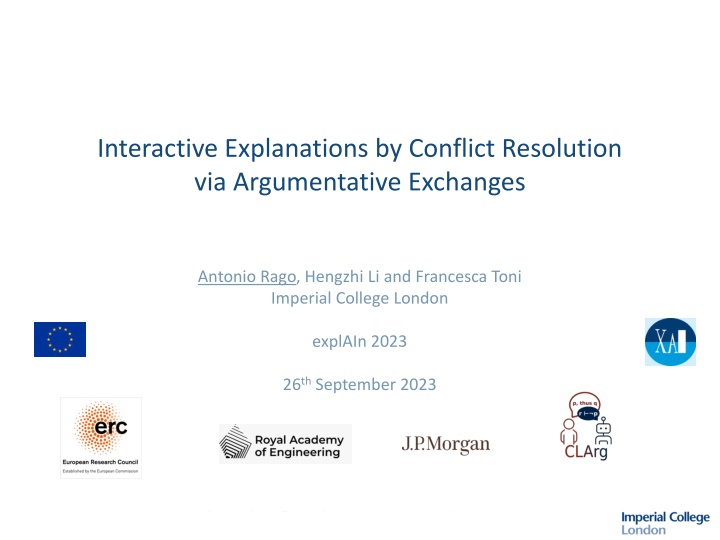
Interactive Explanations by Conflict Resolution via Argumentative Exchanges Study
Explore the study on Interactive Explanations by Conflict Resolution via Argumentative Exchanges, focusing on resolving the lack of interactivity in Explainable AI. The research delves into using computational argumentation for more dynamic and human-centric explanations in AI models.
Download Presentation

Please find below an Image/Link to download the presentation.
The content on the website is provided AS IS for your information and personal use only. It may not be sold, licensed, or shared on other websites without obtaining consent from the author. If you encounter any issues during the download, it is possible that the publisher has removed the file from their server.
You are allowed to download the files provided on this website for personal or commercial use, subject to the condition that they are used lawfully. All files are the property of their respective owners.
The content on the website is provided AS IS for your information and personal use only. It may not be sold, licensed, or shared on other websites without obtaining consent from the author.
E N D
Presentation Transcript
Interactive Explanations by Conflict Resolution via Argumentative Exchanges Antonio Rago, Hengzhi Li and Francesca Toni Imperial College London explAIn 2023 26th September 2023 Interactive Explanations by Conflict Resolution via Argumentative Exchanges Antonio Rago, Hengzhi Li & Francesca Toni 1 / 7
Problem: The Lack of Interactivity in Explainable AI Explainable AI (XAI) targets human understanding of AI models outputs. Dominant methods include feature attribution [Lundberg & Li, 2017] and counterfactuals [Wachter et al., 2018]. As AI advances, the demands on XAI are increasing: Explanations are social a transfer of knowledge, presented as part of a conversation or interaction. [Miller, 2019] However, current methods in XAI are often: Static; Shallow; Machine-centric. Key explanandum machine contributions human contributions ?: movie x is recommended + ?1: the acting in x is great 1: the directing in x is poor + 2: actor a is poor in x ?2: actor b is great in x Machine ( ) Human ( ) Our research question: can argumentation help to resolve these issues? Interactive Explanations by Conflict Resolution via Argumentative Exchanges Antonio Rago, Hengzhi Li & Francesca Toni 2 / 7
Background: Computational Argumentation A bipolar argumentation framework (BAF) [Cayrol and Lagasquie-Schiex, 2005] is a formalism with: ? ?2 = 0.2 ? ?2 = 0.2 Arguments (entities) Attacks (relations) Supports (relations) + ?2 ? ?1 = 0.5 ? ?1 = 0.2 ?1 ? ?3 = 0.8 ? ?3 = 0.8 ?3 We use quantitative bipolar argumentation frameworks (QBAFs) [Baroni et al., 2018]. QBAFs assign a bias? to each argument, e.g. in [0,1]. Semantics may evaluate arguments on a gradual scale, e.g. [0,1], via a strength function ?. We define QBAFs for an argument e, called the explanandum here,such that: e does not attack or support any other argument; For any argument a, there exists a path from a to e via the attacks and supports; The QBAF for e contains no cycles. Interactive Explanations by Conflict Resolution via Argumentative Exchanges Antonio Rago, Hengzhi Li & Francesca Toni 3 / 7
Argumentative Exchanges (AXs) We define triples for an agent ? and explanandum ?: Agent ? ??= [0,1] (??,??,??) = [0,0.5) 0= {0.5} += (0.5,1] ?? ?? ?? + ?? Divided into positive, neutral and negative partitions. 0 ?? is an evaluation range. ??= ?? ??? = 0.5 ??? = 0.2 ?? = e ??= ??,??,??,?? is a QBAF for e. ??: ?? ??is the agent s internal biases on arguments. Note all agents agree on relations as a lingua franca. + a b ??? = 0.2 ??? = 0.2 ?? = ??? = 0.8 ??? = 0.8 ?? = + ??: ?? ??gives ? s final evaluation of arguments. Then, ? s stance on an argument is positive, neutral or negative depending on its strength: + ? ??: ?? = + iff ??? ?? 0 ?? = 0 iff ??? ?? ?? = iff ??? ?? Interactive Explanations by Conflict Resolution via Argumentative Exchanges Antonio Rago, Hengzhi Li & Francesca Toni 4 / 7
Argumentative Exchanges (Cont.) We then define AXs for timestep 0 ? ?: ? is the exchange BAF; ? Each agent has a private triple; We assume that a conflict exists between agents stances on e. As the timestep ? progresses: Agents contribute relations from their private QBAF which attack/support arguments in ? Agents learn any unseen arguments added to the exchange BAF and assign them biases; Agents stances on ? may thus change and the conflict may be resolved. ?; Private to Public to and Private to ? ? ? Exchange BAF ? s Private QBAF ?? s Private QBAF ?? e e e ? = 0 ? = 1 ? = 2 ? = 3 ? = 0 ? = 1 ? = 2 ? = 3 ? = 0 ? = 1 ? = 2 ? = 3 + + + a a a b b b (?,?) ?,? (?,?) (?,?) (?,?) ?,? + + + + c c c f d d d Interactive Explanations by Conflict Resolution via Argumentative Exchanges Antonio Rago, Hengzhi Li & Francesca Toni 5 / 7
Theoretical and Simulation-Based Evaluation of AXs Novel theoretical properties for interactive explanations, which are satisfied for certain cases: Resolution representation in a resolved AX, the exchange BAF must contain arguments which demonstrate how the resolution was achieved; Conflict representation in an unresolved AX, the exchange BAF must contain arguments which demonstrate where the conflict lies. In multi-agent simulations with a machine explaining to a human, we prove some hypotheses, e.g.: When the machine uses static, shallow explanations, as the human s confirmation bias increases, resolution rate decreases. When the machine uses interactive explanations, resolution rate increases relative to shallow, static explanations. When the machine uses interactive explanations, selecting the arguments argumentatively increases resolution rate and contribution accuracy relative to selecting greedily. Interactive Explanations by Conflict Resolution via Argumentative Exchanges Antonio Rago, Hengzhi Li & Francesca Toni 6 / 7
Conclusions & Future Work We introduced the novel concept of AXs: Defined generally but deployed in XAI, where a machine explains to a human; Demonstrated properties of interactive explanations based on conflict resolution; Defined agent behaviour and proved hypotheses, e.g. the strongest argument may not always be the most effective. Opens several potentially fruitful avenues for future work: More experiments with different contexts, restrictions and relaxations; User studies to examine how well agents with QBAFs can model human behaviour; We have deployed AXs in image classification where AI models debate one another. Thanks for your attention! Interactive Explanations by Conflict Resolution via Argumentative Exchanges Antonio Rago, Hengzhi Li & Francesca Toni 7 / 7






















